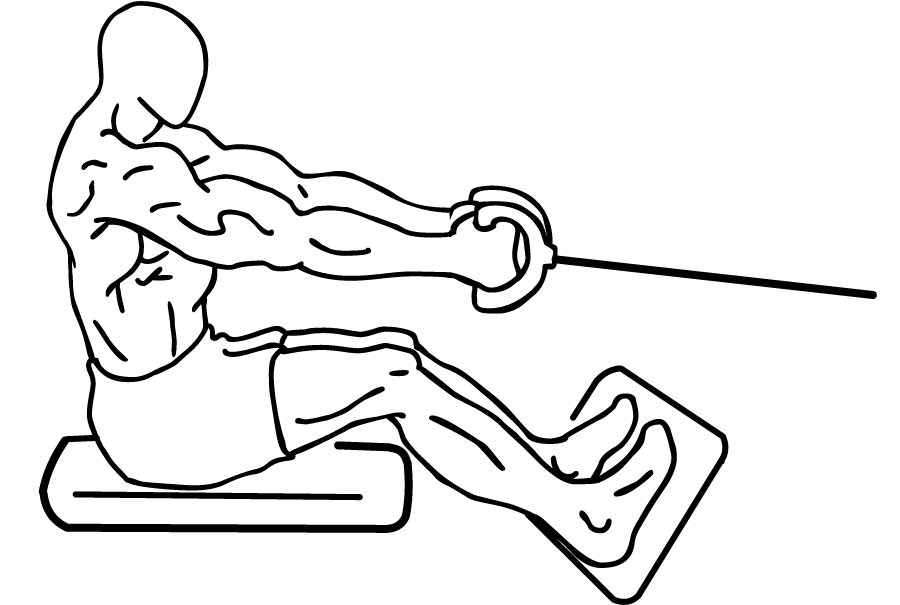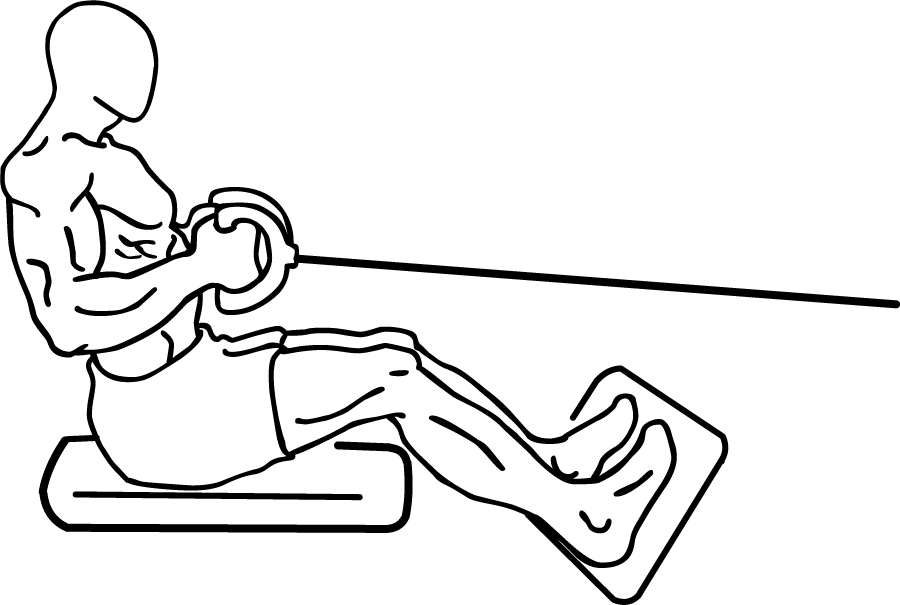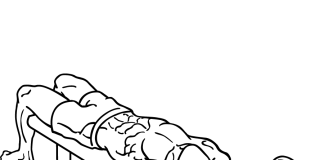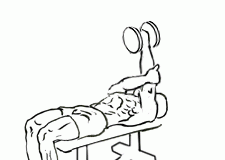Last Updated on September 27, 2014
Seated Cable Rows are a staple in strength training routines for back development. This exercise primarily targets the middle back muscles, but it also engages the biceps, forearms, and even the core, providing a well-rounded upper body workout. Performing the exercise with proper form helps to build a strong, balanced back, improve posture, and enhance pulling strength for other exercises.
Benefits of the Seated Cable Row
- Improved Back Strength: By targeting the lats, rhomboids, and traps, seated cable rows help build a strong back, which supports good posture and reduces the risk of back injuries.
- Enhanced Posture: Strengthening the muscles of the back helps pull the shoulders back and support the spine, which is especially useful if you spend a lot of time seated or at a desk.
- Increased Pulling Power: A strong back improves performance in other pulling exercises, such as deadlifts, pull-ups, and bent-over rows.
- Core Engagement: The exercise also engages the core, making it an excellent choice for those looking to improve both strength and stability.
- Joint Stability: Seated cable rows are low-impact and help to stabilize the shoulder joints, making them ideal for those looking to build strength without putting excess stress on the joints.
Step-by-Step Guide: Performing the Seated Cable Row
To get the full benefits of the seated cable row, here is a breakdown of how to set up, execute, and finish the movement with correct form.
1. Setting Up the Equipment
- Cable Machine: Find a seated cable row machine at your gym or attach a straight or V-bar to a low cable pulley machine.
- Weight Selection: Choose a weight that allows you to perform the exercise with control. Start light, as this helps you master the form before adding heavier weights.
2. Starting Position
- Foot Placement: Sit on the machine’s bench and place your feet firmly on the footrests. Your knees should be slightly bent.
- Grip: Grab the handle with an overhand grip (palms facing down), or if you are using a V-bar, your palms will face each other in a neutral grip.
- Posture: Keep your back straight, core engaged, and shoulders relaxed. Avoid rounding or arching your back, as this could lead to injury.
- Lean Forward Slightly: While maintaining a straight spine, lean forward slightly to grasp the handles. Your arms should be extended, with a slight bend in the elbows to prevent locking the joints.
3. Executing the Row
- Engage Core and Begin the Pull: Brace your core and pull the handle toward your abdomen in a controlled motion. Focus on pulling with your back muscles rather than just your arms.
- Elbow Position: Keep your elbows close to your body as you row the handle toward you. This positioning maximizes back engagement.
- Full Contraction: Pull until the handle reaches your midsection or slightly above the belly button. Squeeze your shoulder blades together to fully activate the rhomboids and traps.
- Pause and Hold: Hold the contraction for a second at the top of the movement, focusing on squeezing your back muscles.
- Controlled Return: Slowly extend your arms, allowing the handle to move back to the starting position. Maintain control throughout the movement, keeping your back straight and abs engaged.
4. Breathing Technique
- Inhale during the forward motion, as you bring the handle back to the starting position.
- Exhale as you pull the handle toward your abdomen, engaging your core.
Muscles Targeted in the Seated Cable Row
Understanding the anatomy involved can help you focus on specific muscle groups during the exercise.
- Latissimus Dorsi (Lats): These large, wing-shaped muscles run along the sides of your back, giving your upper body a broader appearance. They’re heavily activated during the rowing motion.
- Rhomboids: Located between the shoulder blades, the rhomboids are engaged as you pull your shoulder blades together. This movement helps build the “thickness” of the back.
- Trapezius (Traps): The traps, especially the middle and lower portions, assist in the rowing movement and contribute to a stronger, well-rounded upper back.
- Biceps: While the back muscles are the primary focus, the biceps act as secondary movers during the exercise, assisting in the pull.
- Rear Deltoids: These muscles at the back of your shoulders are also engaged, helping to stabilize the shoulder joint.
- Core Muscles: Your core works to stabilize your body throughout the exercise, ensuring good posture and preventing swaying.
Common Mistakes and How to Avoid Them
Correct form is essential to avoid injury and maximize results. Here are some common mistakes people make with seated cable rows, along with tips on how to correct them.
- Rounding the Back: Keep your back straight and avoid hunching or rounding. A rounded back places undue stress on the lower spine, which could lead to injury.Tip: Focus on maintaining a proud chest position, and engage your core to support your lower back.
- Using Excessive Weight: Going too heavy can compromise your form and increase the risk of injury. When lifting too heavy, people tend to jerk the weight, losing control.Tip: Start with a manageable weight that allows you to move through the full range of motion without straining.
- Swaying Back and Forth: Leaning excessively or swinging the torso reduces back engagement and puts pressure on the lower back.Tip: Keep your body stable throughout the movement, allowing only your arms and shoulder blades to move.
- Locking the Knees: Locked knees put unnecessary stress on the joints, and it becomes harder to maintain a stable posture.Tip: Keep a slight bend in your knees at all times to stay stable and avoid joint strain.
- Elbows Flaring Out: When your elbows flare out, your shoulders take over the movement, reducing back engagement.Tip: Keep your elbows close to your torso, allowing your back muscles to do the work.
Variations of the Seated Cable Row
To add variety to your workout and target different muscles, try these variations of the seated cable row:
- Wide Grip Seated Cable Row: Use a wide bar attachment and take a wider grip. This variation emphasizes the upper back and rear deltoids, making it ideal for building back width.
- Single Arm Seated Cable Row: Attach a single handle and row with one arm at a time. This variation helps correct muscle imbalances and allows you to focus on each side individually.
- Underhand Grip Row: Hold the bar with your palms facing up. This grip places more emphasis on the lower lats and biceps.
- Resistance Band Seated Row: If you don’t have access to a cable machine, use a resistance band to perform seated rows. Anchor the band to a sturdy object, sit down, and proceed with the same movement.
- Seated Cable Row on a Stability Ball: Instead of sitting on a bench, sit on a stability ball. This adds an extra balance challenge, engaging your core even more.
Tips for Maximizing the Seated Cable Row
- Focus on the Mind-Muscle Connection: Actively concentrate on engaging your back muscles, particularly the lats and rhomboids, to get the most out of each repetition.
- Experiment with Tempo: Slow down the eccentric (return) phase to increase time under tension, which can lead to better muscle growth.
- Squeeze at the Top: When you reach the peak of the row, squeeze your shoulder blades together for maximum back activation.
- Use a Moderate Weight: A controlled movement is more effective than lifting heavy weights with poor form. Focus on control to ensure that your back, not your arms, drives the movement.
- Include in a Superset: To really fatigue the back muscles, try pairing seated cable rows with another back exercise, like lat pulldowns or bent-over rows, in a superset.
Sample Workouts Incorporating Seated Cable Rows
Here are some examples of how to incorporate seated cable rows into your workout:
Back-Focused Workout
- Pull-Ups: 3 sets of 8-10 reps
- Lat Pulldown: 3 sets of 10-12 reps
- Seated Cable Row: 3 sets of 10-12 reps
- Bent Over Barbell Row: 3 sets of 8-10 reps
- Face Pulls: 3 sets of 12-15 reps
Full Upper Body Workout
- Bench Press: 4 sets of 6-8 reps
- Overhead Shoulder Press: 3 sets of 8-10 reps
- Lat Pulldown: 3 sets of 10-12 reps
- Seated Cable Row: 3 sets of 12-15 reps
- Bicep Curls: 3 sets of 10-12 reps
- Tricep Pushdowns: 3 sets of 10-12 reps
Core and Back Stabilization Workout
- Deadlift: 4 sets of 6-8 reps
- Bird Dog: 3 sets of 15 reps per side
- Plank Row: 3 sets of 12 reps per side
- Seated Cable Row: 3 sets of 10-12 reps
- Back Extensions: 3 sets of 15 reps
Frequently Asked Questions
1. Can beginners do seated cable rows?
Yes, seated cable rows are beginner-friendly as long as you use a weight that allows you to maintain proper form.
2. How much weight should I start with?
Start with a light to moderate weight—about 10-20 pounds is a good range for beginners. Gradually increase as you get more comfortable.
3. Can I do seated cable rows every day?
While it’s safe to do, it’s best to allow your muscles time to recover. Most recommend training the back 2-3 times per week.
4. Are seated cable rows safe for those with lower back issues?
If you have lower back issues, consult a doctor before performing this exercise. Keeping the spine neutral and avoiding excessive weight can reduce risk, but always prioritize safety.
Final Thoughts
The Seated Cable Row is a versatile, effective exercise that provides numerous benefits for back strength and stability. By mastering the correct form, avoiding common mistakes, and incorporating it into your workout routine, you can achieve a well-developed, strong, and functional back. The exercise’s variations and adaptations make it accessible to people of all fitness levels, allowing for a wide range of progression as you build strength and improve posture.








